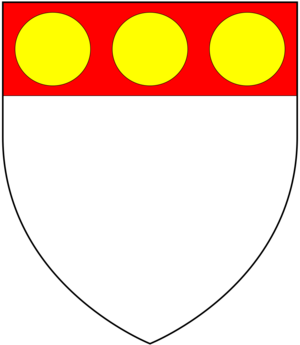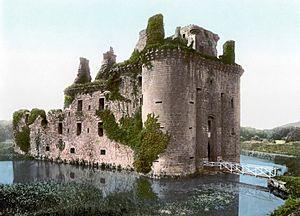William Russell (knight) facts for kids
Sir William Russell (born in 1257, died in 1311) was an important English nobleman and knight. He owned part of a large estate called the feudal barony of North Cadbury in Somerset. However, he spent most of his life working to manage and protect the Isle of Wight. He gained the manor of Yaverland on the island through his marriage. Sir William was also in charge of Carisbrooke Castle. He served in the English Parliament twice, first representing Great Bedwyn and later the County of Southampton. King Edward I, known as "Hammer of the Scots," often asked Sir William to serve in his army because of his noble status.
Contents
Sir William Russell's Family Background
William Russell was the third son of Sir Ralph Russell, who was born in 1204. His grandfather was Sir John Russell (who died around 1224). Sir John was an important official, or steward, for King John and later for his young son, King Henry III. King John had given Sir John the Kingston Russell estate.
William inherited part of the Newmarch barony of North Cadbury from his mother, Isabel de Newmarch. Even though the other half went to his aunt's husband, this inheritance made William a member of the baronage. This meant he had many important duties and responsibilities.
Marriage and New Home
Around 1280, William Russell married Katherine de Aula. Katherine was the heiress of the de Aula family, who lived on the Isle of Wight. Through this marriage, the Russell family gained the Yaverland manor on the Isle of Wight. This became their main home.
Protecting the Isle of Wight
Sir William Russell lived at Yaverland for the rest of his life. He played a very important role in defending the Isle of Wight from frequent attacks by the French. He was chosen as one of three Wardens of the Island. He also became the Constable of Carisbrooke Castle. This castle was the main center of power on the island, and all other estates were connected to it through feudal agreements. In 1294, the King told Sir William to prepare the island for a possible invasion by France.
Serving the King
In 1295, while his older brothers were still alive, Sir William was elected to Parliament. He represented Great Bedwyn in Wiltshire, where his family owned another estate. In 1297, King Edward I called on him to join other nobles in London. They were getting ready for a military trip to Flanders.
Sir William was also called to York in 1298 to fight against the Scottish leader William Wallace. He fought in the Battle of Falkirk, where the English won a big victory. However, the Scottish forces regrouped. So, Russell was called again to join King Edward's army in 1300 at Carlisle.
He was present at the Siege of Caerlaverock later that year. During this siege, his family's coat of arms was recorded by the heralds, who were like official record-keepers of noble families. Russell was called again in 1301 to be ready at Carlisle. The army then spent a difficult winter in Scotland.
In 1302, he was appointed a Warden of the Isle of Wight for a second time, along with Sir John de Lisle. In 1307, King Edward I, "Hammer of the Scots," called Sir William again. He was to join the royal army at Carlisle to fight against Robert the Bruce. Before this campaign began, the King decided to knight his son. Parliament gave him a special tax, called a feudal aid, to pay for the grand ceremony. Russell was chosen to collect this tax for the county of Southampton. The army didn't have to fight on this occasion because Bruce had already been defeated by other nobles.
Sir William's Later Years
King Edward II became king in 1307. He called his first Parliament to meet at Northampton. Sir William Russell was called to attend for the county of Southampton. Russell then gave up his duties as Constable of Carisbrooke Castle to Nicholas de Bois.
In 1308, Sir William was appointed as one of three judges for the Channel Islands. Their job was to investigate if anyone was taking money that belonged to the King. In 1309, Russell was called to Newcastle upon Tyne with his horses, weapons, and all his loyal followers. This was to punish the Scots for breaking a recent peace agreement. By this time, Russell was not well. He couldn't go himself, so he sent other knights to serve in his place. Sir William Russell died in 1311. He left behind one son, Theobald Russell, who was only seven years old.
What Happened Next
William's young son, Theobald (1303–1349), was placed under the care of Ralph III, Baron Gorges. Baron Gorges arranged for Theobald to marry his second daughter, Eleanor. Eleanor later became one of three co-heiresses to her brother, Ralph IV, who died without sons.
Theobald and Eleanor had five sons. The oldest was Sir Ralph Russell (who died in 1375). He inherited the Russell family lands. His direct male family line ended when his grandson, Sir Maurice Russell (1356–1416), died. Theobald I and Eleanor's second son was Theobald II Russell. He inherited most of the Gorges family lands from his uncle, the second Baron Gorges, who had no sons. Theobald II agreed to change his family name and coat of arms to Gorges. This started a new line of the "Gorges" family. The history of the youngest three sons, William, John, and Richard, is not well known.





